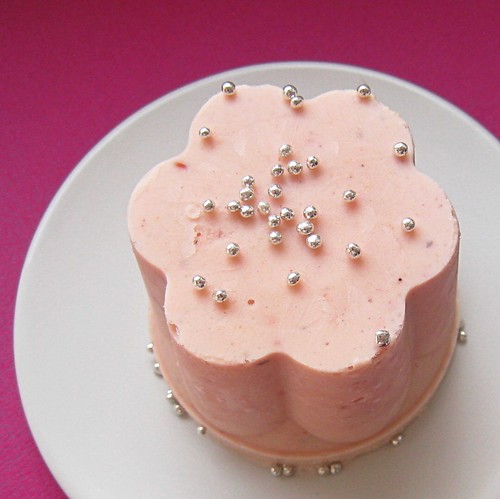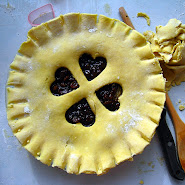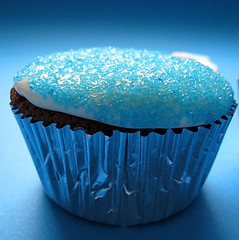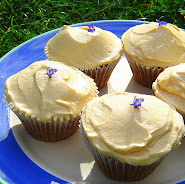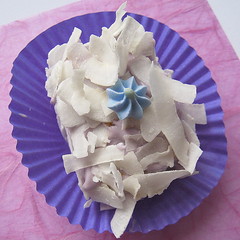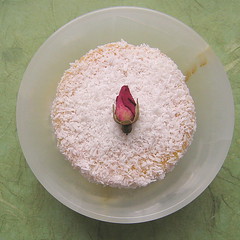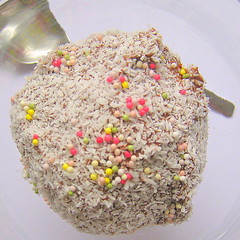I should be sweeping the front yard. I know, just know, that it is going to rain shortly, and I need to get rid of the grit and compost that re-doing out flowerpots this weekend created.
Oh well, too late. The skies just opened. I guess it'll have to be tomorrow.
Instead, I shall use this time semi-productively and get on with a book review I was meant to do ages ago.
I was sent (about ten thousand years ago) by the very kind people at Michael Joseph a review copy of Cookery School, which is a companion book to a Channel 4 TV series that was on a while ago. I didn't actually watch the programme myself, so I can't really tell you much about it, other than it was presented by Richard Corrigan and Gizzy Erskine.
I know who Richard Corrigan is, and if we're judging by appearances (which I know we're told not to, but still...), I would definitely attend a cookery school that he was teaching at. The man clearly likes a plate or two of food. This in mind, I was quite interested to see what delights lay within the book when it arrived. But more on that later.
Miss Erskine, I have discovered since reading the book, has in the past worked with Harry 'puts vegetables in cakes instead of butter and pretends it's normal' Eastwood, which made me feel quite vomitous to tell you the truth. But I also read somewhere that she used to be a body piercer, so I'm going to award her 5 Fierce Points and let her off for the Eastwood misdemeanor (for now).
(Maybe I should give Harry Eastwood a break.)
It doesn't really matter who the chefs that fronted the programme are actually, since very little of their personalities seem to shine through in Cookery School. Gizzy's sections (tips on topics such as cheese, meat and herbs) are quite conversational in style, but seem rushed (she repeats herself often and relies on the word 'brilliant' too much to describe food). They could have been much better arranged on the page, particularly the herbs feature. She singles out sorrel, for example, as being underrated and encourages readers to look out for it growing wild, but there is not an accompanying picture to show you what to look for.
The lack of clear explanation (and assumption that readers already possess a certain level of knowledge about cooking and food) continues in Richard's recipes. Ingredients I had never heard of, such as lardo, are routinely listed in recipes without footnotes. Perhaps most people already know what lardo is (did you?), but I fail to see how a book that dedicates two whole pages to a step by step process of how to peel and core apples and pears can logically assume it's readers will have a knowledge of foreign ingredients but be unable to properly cut fruit.
Perhaps I am being overly negative. But the subtitle of the book '- where anyone can learn to cook' is, I feel, misleading. It makes it sound like this is a volume for absolute beginners, which it most certainly is not. It is a collection of cheffy dishes made with expensive ingredients.
There were some things I did like about the book. It is divided into clear sections: basic, intermediate and advanced. I must admit I like the idea of a challenge to work through, and it certainly ties in with the idea of a cookery school, but again there seems to have been a strange system of classification in place for the recipes themselves. Roast chicken is apparently 'super advanced' (as is trifle), whereas guinea fowl hash with fried quails eggs is considered basic. Really, Richard? Where am I even going to get guinea fowl?
In the interest of testing out the book on its own terms, I made the coffee cake from the advanced chapter, and considered pork chops, but couldn't be bothered with all that apple and cream rubbish. I had them with cinnamon instead.
I should say up front that I did, despite my lack of love for the book overall, learn a thing or two from the process. For example, that using cold espresso in butter icing gives you amazing coffee flavour (put that Nescafé down), and how to French trim a pork chop.
If you are a cook who wants to learn how to do cheffy things in your kitchen, Cookery School might be a good book for you to consider. But if you really want a basic course in home cooking, get this
I didn't go in for all the piping kerfuffle, which may have been the reason it was in the advanced section. I also didn't caramalize any nuts. But here's the recipe in case you want to make an advanced coffee cake like I did.
Advanced Coffee Cake
You will need:
300g unsalted butter, room temperature
300g caster sugar
5 eggs
300g self raising flour, sifted
1 tsp baking powder
60ml cold espresso
milk, as needed
200g soft butter
400g icing sugar
60ml cold espresso
- Grease and line two 22cm round cake tins. Heat the oven to 180°C.
- Cream the butter and sugar until light and fluffy, then add the eggs one at a time, beating well after each one goes in.
- Fold in the flour and baking powder, followed by the coffee, and if needed, milk, to lighten the mix.
- Divide between the tins and bake for 30 minutes or until a cake tester inserted into the centre of the cake comes out clean.
- Cool in the tins for 10 minutes, then turn out onto a wire rack. When cool, fill with the icing, which is very easy to make: beat the icing sugar, butter and coffee together until creamy and thick.





